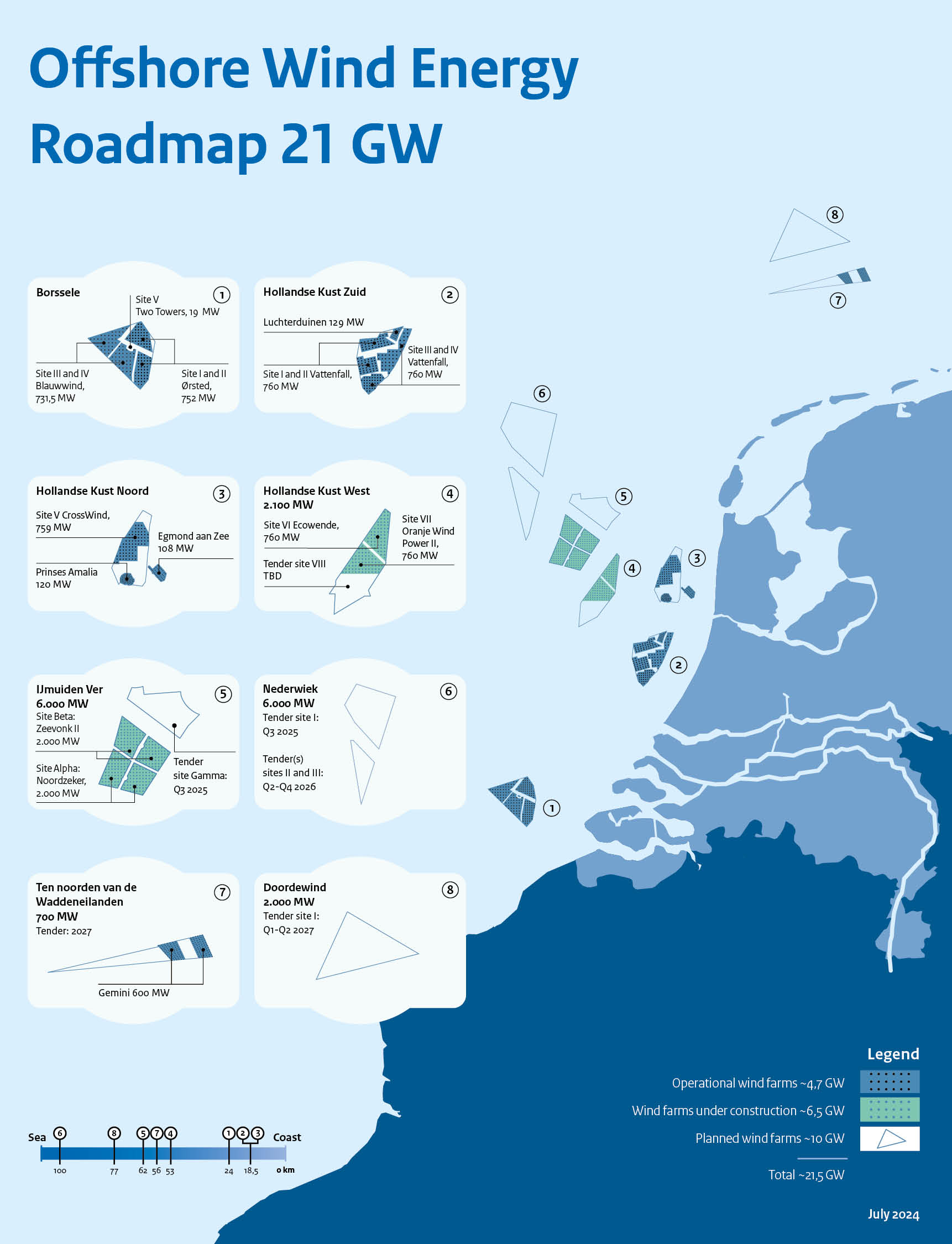A Roadmap To Success
In the last decade, the Dutch Government has taken a proactive approach to offshore wind development, ensuring long-term visibility of project pipelines and minimal risk for potential developers and investors.
As a result, the Netherlands has become a front-runner in cost-efficient offshore wind development and installation. To reach this position, the Dutch had to completely rethink their approach to the sector.
Up to 2017, project developers were responsible for site selection and investigation, as well as having to go through the permitting process with no guarantee projects would be approved. As a result, they faced high costs and risks before they could even apply for a subsidy. Of 80 initial applications, just four offshore wind farms with a combined capacity of less than 1 GW were actually built in the Dutch Economic Zone of the North Sea by that time.
In 2013, a broad coalition of Government, employers’ associations, trade unions, environmental organisations and the energy industry agreed things needed to change and so began the Dutch energy transition. The resulting Energy Agreement for Sustainable Growth (Energy Agreement) included ambitious targets to raise the share of renewables in the energy mix to 14% by 2020 and 16% by 2023. By 2050, the country hopes to be fully climate neutral with a net zero energy supply, with offshore wind power expected to play a major role in achieving this.

Roadmaps
Offshore wind was therefore put at the heart of the planned energy transition, with the Offshore Wind Energy Act introduced in 2015 (updated in 2021) and the Government going on to publish the country's first Offshore Wind Energy Roadmap. This first Roadmap outlined plans to boost the country's operating offshore wind capacity to 4.5 GW by 2023 and included a clear schedule for tenders and subsequent project development.
Three offshore wind farm zones – Borssele, Hollandse Kust (zuid) and Hollandse Kust (noord) – were officially designated for development under the 2023 Roadmap. Significantly, the Hollandse Kust (zuid) project – totalling 1.5 GW across four sites – was the first in Europe to be subsidy-free. All subsequent Dutch offshore wind projects which have been tendered, including the 759 MW Hollandse Kust Noord, are also being developed without subsidy.
A new Offshore Wind Energy Roadmap was published in 2019, this time aiming for around 11.5 GW operational offshore wind power by end 2030. Three new wind farm zones were allocated under this 2030 Roadmap – Hollandse Kust West (1.4 GW, subsidy-free tenders completed in 2022), IJmuiden Ver (4 GW, a combined tender is due late 2023), and Ten Noorden van de Waddeneilanden (0.7 GW, tender currently planned 2026/27).
Additional action
In 2022, the offshore wind target was further raised to 21 GW by 2032. These wind farms will then supply 16% of the energy we need in the Netherlands. That is equivalent to approximately 75% of our current electricity consumption. This means that offshore wind energy will make a major contribution to helping the Netherlands become more sustainable.
Offshore Wind Energy Roadmap
The Offshore Wind Energy Roadmap shows where wind farms are located or will be built and which Offshore Wind Farm Zones are designated for new wind farms in the future. The letter to Parliament of 26 April 26 2024 contains the planning schedule for offshore wind farms. The table below shows when we will issue a permit for these wind farms and when the future developer is likely to put the wind farm into use. Offshore wind farms already under construction are also in the table.
Planning for net zero in 2050
Because the Netherlands is becoming more sustainable, our electricity consumption is increasing. We use more and more (green) electricity instead of fossil fuels. Offshore wind energy supplies 'clean' electricity and that is why we will also need a lot of it in the future. The Government is aiming to have approximately 50 GW of offshore wind energy installed in 2040 and approximately 70 GW in 2050.
Also read > Dutch Offshore Wind Policy Approach
The Dutch Approach
In the Netherlands, the Government has taken on responsibility for developing offshore wind projects itself. It has introduced a stable policy environment with clear project pipelines and timetables outlined in a series of (updated) Offshore Wind Energy Roadmaps, the latest targeting 21 GW of operating capacity by 2032.
There are now flexible rules and regulations for offshore wind development while the Netherlands Enterprise Agency (RVO.nl) co-ordinates all site studies for each wind farm. This approach provides greater certainty for developers, increases investor confidence, and has been proven to foster innovation and drive down overall costs for offshore wind projects.
In a move that highlights the forward-thinking global leadership of the Netherlands in the offshore wind sector, the latest subsidy-free project tenders already have a strong emphasis on qualitative criteria, notably for system integration and ecological initiatives, rather than just lowest cost. This is to ensure smooth integration of the electricity from future offshore wind farms into the energy system, minimal impact on the environment and maximum benefit to society at reasonable cost. Options to use offshore wind generated electricity to produce green hydrogen are also under investigation.
